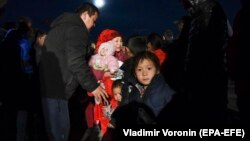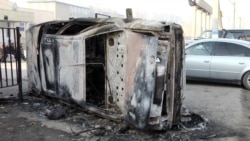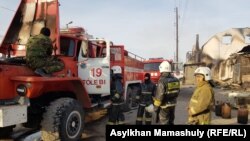
The government of Turkmenistan has a long-established habit of ignoring bad news.
Dire economic problems, natural disasters, war on the border: as far as Turkmen authorities and state media were concerned, it never happened, even when the people of the country could see it for themselves.
The recent global concern over the spread of the new strain of coronavirus from China is another example.
As the world was finding out more every day in January about the spread of the coronavirus inside and outside China, neither the Turkmen government or the media mentioned the topic. Actually, they still haven't.
But at the end of January, Turkmen officials started quietly taking certain measures: flights to and from China were canceled, students and other Turkmen citizens in China were brought home -- not flown to Ashgabat but rather to the eastern Lebap Province, where a quarantine center had been set up.
Additionally, greater attention was paid to sanitary conditions at some public facilities, such as schools, kindergartens, and hospitals in Mary Province, where even the traditional Turkmen remedy of burning camel-thorn trees was employed.*
There still was not a word publicly from officials or state media specifically about the coronavirus, which, again, is not surprising for the Turkmen authorities, considering recent practice.
Sudden Policy Change
For that reason it is somehow disquieting that suddenly, just a few days into February, authorities in the capital, Ashgabat, started distributing booklets on "what to know about the coronavirus" to hospitals and schools.
Health workers are even passing out pamphlets about the virus to people on the streets around the capital.
Health officials are also reportedly speaking to students in Ashgabat about precautionary measures they should take to avoid the "flu and hepatitis."
And although there are no reports of booklets being distributed to people in the regions, Turkmen health officials have reportedly started speaking with people about the coronavirus in towns around the country.
While this new campaign to inform the public about the virus and how to prevent its spread is commendable, it is also unprecedented for Turkmenistan. There has never been such a public-awareness campaign in Turkmenistan about a potential health hazard before this.
It is tempting to say that because President Gurbanguly Berdymukhammedov was previously the country's health minister, this a problem he understands.
But since he was a dentist by training, not a virologist, and his biggest accomplishment as health minister was closing down regional health centers, this reasoning seems unlikely.
The independent Turkmen.news website, which is based in Europe, reported on February 7 that one young man who had been evacuated from China had died in the quarantine camp in Lebap Province and that his body was cremated, which is an uncommon practice in Central Asia.
RFE/RL's Turkmen Service, known locally as Azatlyk, could not confirm this report, but did confirm the presence of the quarantine area in Lebap and that Turkmen who had returned from China who were being kept there for observation -- far from the public eye -- were able to contact their relatives regularly.
There are an unknown number of Chinese workers at the Bagtyyarlyk gas field in Lebap Province, which is operated by the China National Petroleum Corp (CNPC). Some of them are also reportedly in the Lebap quarantine camp.
There is no evidence that suggests the coronavirus is present in Turkmenistan.
Neighboring Central Asian countries have people in quarantine also, but so far, no Central Asian government has reported any confirmed case of coronavirus.
As for why the unprecedented campaign for public health unawareness started so suddenly and so late, that could be due to international health groups, such as the World Health Organization, urging countries to take steps to educate their populations about the virus and Turkmenistan has simply decided to finally comply with this advice.
It could also be that in this instance, Turkmenistan's elite are on equal footing with the population. A virus doesn't discriminate between ruler and the ruled.
Berdymukhammedov uncharacteristically vanished from public view for several weeks in July 2019 and was widely believed to have been severely ill. He is rumored to suffer from diabetes.
It could also simply be that for once, Berdymukhammedov sees that his future could be tied to the well-being of his people.
*According to the Turkmen Health Ministry, "Grass and flowers of camel thorn are used as anti-inflammatory and antiseptic agents for diseases of the gastrointestinal tract.










